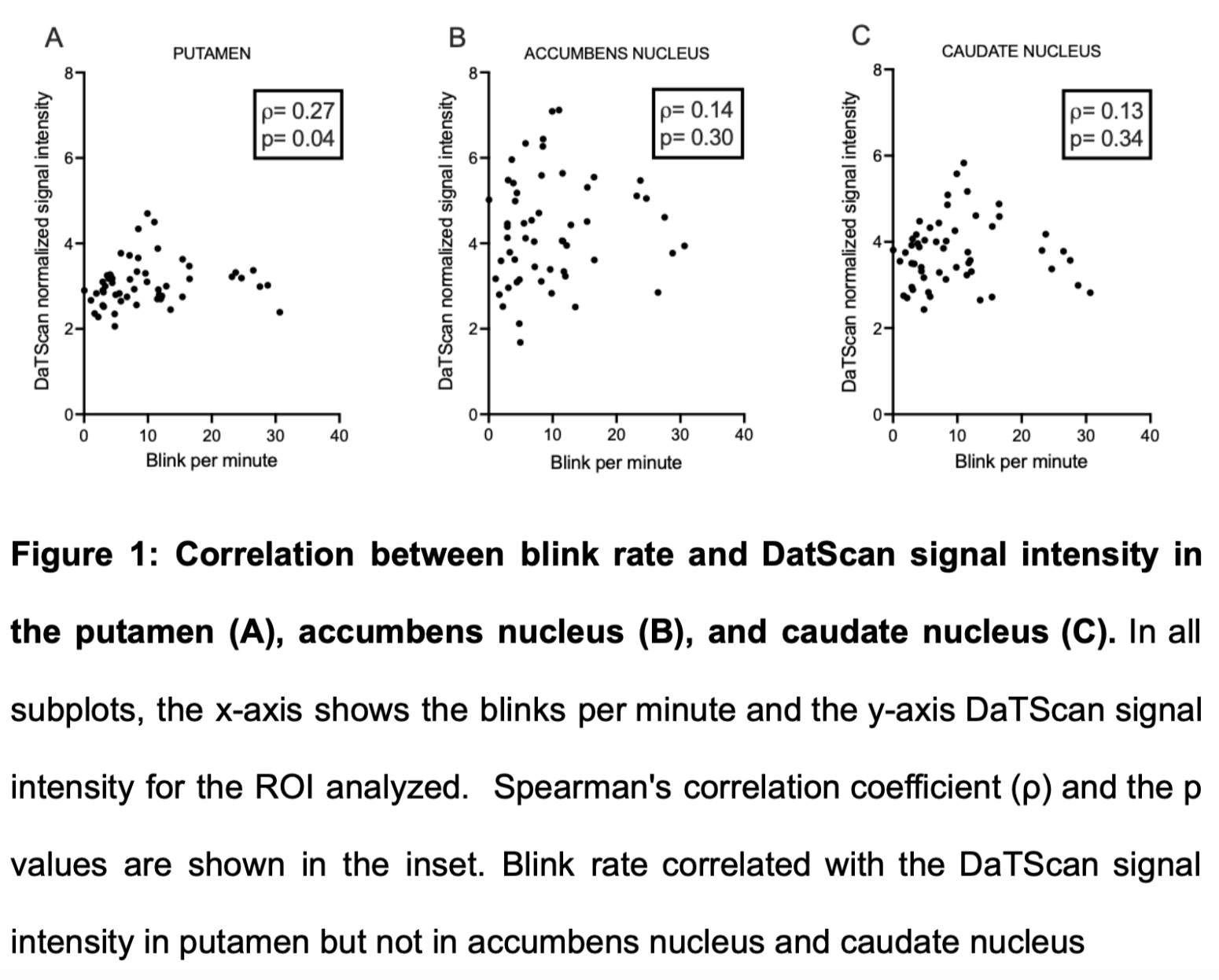Category: Parkinson's Disease: Pathophysiology
Objective: To examine the relationship between blink rate and DaTScan in Parkinson’s disease.
Background: Spontaneous eye-blink rate (BR) is blinking without external triggers. Parkinson’s disease (PD) patients showed a decrease in BR [1–4], which is expected given the link between dopamine activity and BR [1,5,6]. The studies investigating the relationship between BR and PD characteristics have inconsistent conclusions, due to variability of blink measure and small cohort sizes [1,4]. Although BR is included in the MDS-UPDRS assessment as part of facial expression [7], it is not a quantified assessment. Since blinking is related to cognitive and motor processing, it is critical to do a quantitative assessment using standardized methods of EOG [3] or eye tracking [8]. To initiate progress towards this, we analyzed eye-tracking data from PD patients and investigated the relationship of BR to dopamine deficiency from a DaTScan.
Method: Eye tracking data from 54 PD patients were analyzed in the best-ON condition while they performed reflexive horizontal saccades collected in 2 blocks (video-eye tracker-SMI (500 Hz) and ey(e)brain software). Blink detection was done on each block using a custom algorithm (Matlab). The BR was calculated as the number of blinks per minute. Each patient also performed a DaTScan. The regions of interest over putamen, accumbens, and caudate nucleus were segmented and the normalized mean bilateral signal intensity was used for correlation analysis (Spearman’s ρ coefficient; results considered significant for p≤0.05).
Results: The BR was found to be correlated with DaTScan signal intensity in putamen (Spearman correlation-SC: ρ=0.27; p=0.04) but no significant correlation was observed in accumbens nucleus (SC, ρ=0.14; p=0.30) or caudate nucleus (SC, ρ=0.13; p=0.34) (Figure 1). We found no correlation between BR and UPDRS-III scores in ON and OFF-levodopa medication conditions (respectively ρ=-0.10, p=0.49, n=50 and ρ=-0.19, p=0.16, n=54). The age of patients and PD duration did not correlate with BR (respectively ρ=0.19, p=0.16, n=54 and ρ=-0.09, p= 0.49, n=54).
Conclusion: Blink assessment is a simple, sensitive, and non-invasive test to study the anatomic-functional alterations in PD. Our results suggest that BR may be considered a potential marker for the motor network alterations (reduced DaTScan signal intensity in the putamen) independent of the associative and limbic networks (accumbens and caudate nucleus).
Figure 1
References: 1. Karson CN. SPONTANEOUS EYE-BLINK RATES AND DOPAMINERGIC SYSTEMS. Brain. 1983;106(3):643–53.
2. Hall A. THE ORIGIN AND PURPOSES OF BLINKING. Br J Ophthalmol. 1945 Sep 1;29(9):445–67.
3. Kaneko K, Sakamoto K. Spontaneous blinks of Parkinson’s disease patients evaluated by EMG and EOG. Electromyogr Clin Neurophysiol. 2001 Mar;41(2):87–95.
4. Fitzpatrick E, Hohl N, Silburn P, O’Gorman C, Broadley SA. Case–control study of blink rate in Parkinson’s disease under different conditions. J Neurol. 2012 Apr;259(4):739–44.
5. Agostino R, Bologna M, Dinapoli L, Gregori B, Fabbrini G, Accornero N, et al. Voluntary, spontaneous, and reflex blinking in Parkinson’s disease. Mov Disord. 2008 Apr 15;23(5):669–75.
6. Iwaki H, Sogo H, Morita H, Nishikawa N, Ando R, Miyaue N, et al. Using Spontaneous Eye-blink Rates to Predict the Motor Status of Patients with Parkinson’s Disease. Intern Med. 2019 May 15;58(10):1417–21.
7. Goetz CG, Tilley BC, Shaftman SR, Stebbins GT, Fahn S, Martinez‐Martin P, et al. Movement Disorder Society‐sponsored revision of the Unified Parkinson’s Disease Rating Scale (MDS‐UPDRS): Scale presentation and clinimetric testing results. Mov Disord. 2008 Nov 15;23(15):2129–70.
8. Kimura N, Watanabe A, Suzuki K, Toyoda H, Hakamata N, Fukuoka H, et al. Measurement of spontaneous blinks in patients with Parkinson’s disease using a new high-speed blink analysis system. J Neurol Sci. 2017 Sep;380:200–4.
To cite this abstract in AMA style:
Q. Salardaine, V. Vasudevan, N. Villain, E. Biondetti, S. Lehéricy, M. Vidailhet, P. Pouget. Eye Blink Rate and Putamen DaTScan Covariation in Parkinson’s Disease [abstract]. Mov Disord. 2024; 39 (suppl 1). https://www.mdsabstracts.org/abstract/eye-blink-rate-and-putamen-datscan-covariation-in-parkinsons-disease/. Accessed October 22, 2025.« Back to 2024 International Congress
MDS Abstracts - https://www.mdsabstracts.org/abstract/eye-blink-rate-and-putamen-datscan-covariation-in-parkinsons-disease/

